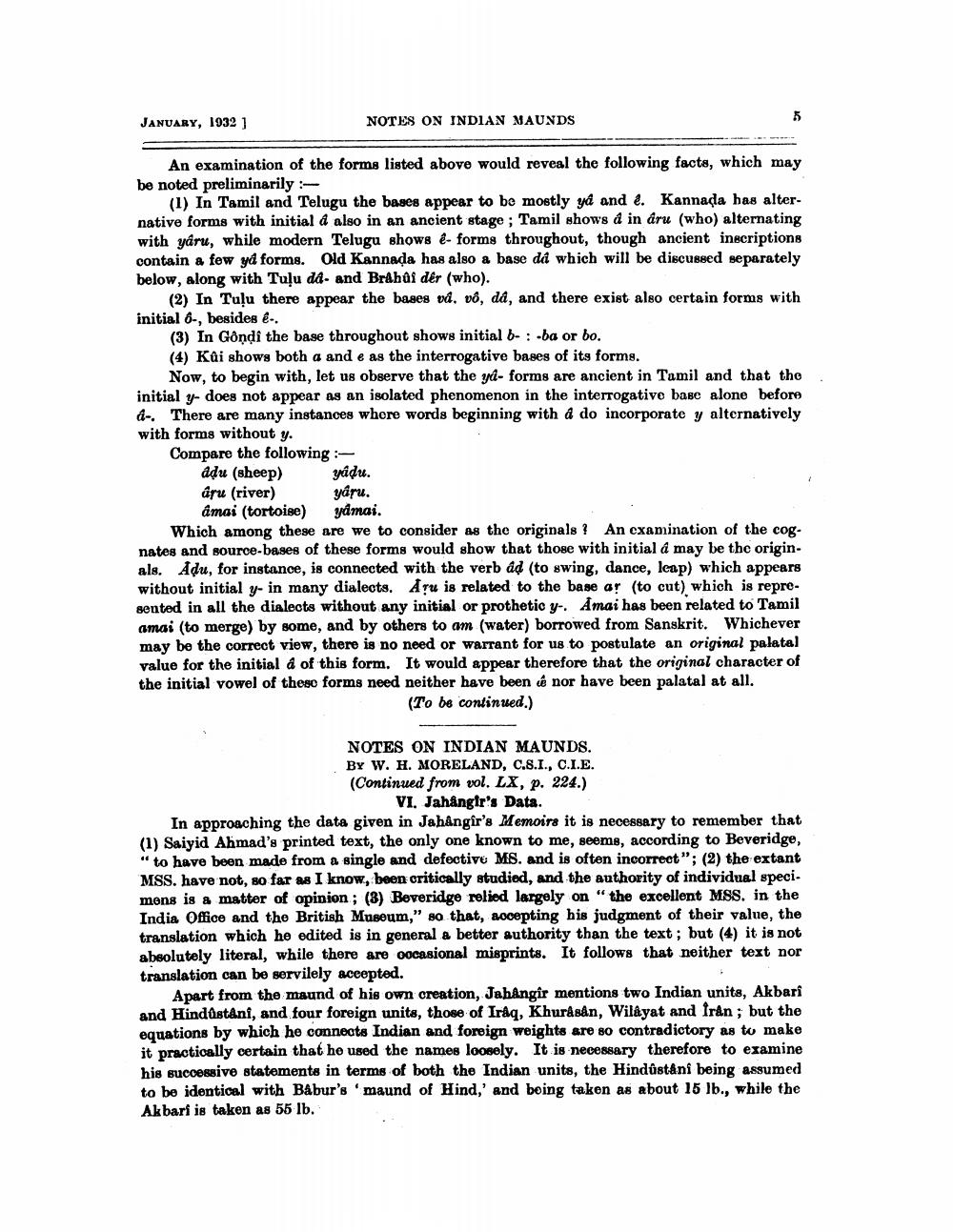________________
JANUARY, 1932)
NOTES ON INDIAN MAUNDS
An examination of the forms listed above would reveal the following facts, which may be noted preliminarily
(1) In Tamil and Telugu the bases appear to be mostly yd and e. Kannada bas alternative forms with initial & also in an ancient stage ; Tamil shows d in dru (who) alternating with yáru, while modern Telugu Bhows e-forms throughout, though ancient inscriptions contain a few yd forms. Old Kannada has also a base de which will be discussed separately below, along with Tulu da. and Bráhôi dêr (who).
(2) In Tuļu there appear the bases ud, vô, dd, and there exist also certain forms with initial 6-, besides é..
(3) In Gôndi the base throughout shows initial b- : -ba or bo. (4) Kai shows both a and e as the interrogative bases of its forms.
Now, to begin with, let us observe that the yd- forms are ancient in Tamil and that the initial y-does not appear as an isolated phenomenon in the interrogative base alone before d-. There are many instances whore words beginning with a do incorporate y alternatively with forms without y. Compare the following:
adu (sheep) yâdu. áru (river) yáru.
åmai (tortoise) ydmai. Which among these are we to consider as the originals ? An examination of the cognates and source-bases of these forms would show that those with initial & may be the originals. Adu, for instance, is connected with the verb ad (to swing, dance, leap) which appears without initial y-in many dialects. Aru is related to the base ar (to cut) which is represented in all the dialects without any initial or prothetic y.. Amai has been related to Tamil amai (to merge) by some, and by others to am (water) borrowed from Sanskrit. Whichever may be the correct view, there is no need or warrant for us to postulate an original palatal value for the initial á of this form. It would appear therefore that the original character of the initial vowel of these forms need neither have been cê nor have been palatal at all.
(To be continued.)
NOTES ON INDIAN MAUNDS. BY W. H. MORELAND, C.S.I., C.I.E. (Continued from vol. LX, p. 224.)
VI. Jahangir's Data. In approaching the data given in Jahangir's Memoirs it is necessary to remember that (1) Saiyid Ahmad's printed text, the only one known to me, seems, according to Beveridge, "to have been made from a single and defective MS. and is often incorrect"; (2) the extant MSS. have not, so far as I know, been critically studied, and the authority of individual speci. mons is a matter of opinion ; (8) Beveridge relied largely on "the excellent MSS. in the India Office and the British Museum," so that, accepting his judgment of their value, the translation which he edited is in general a better authority than the text; but (4) it is not absolutely literal, while there are oocasional misprints. It follows that neither text nor translation can be servilely accepted.
Apart from the maund of his own creation, Jahangir mentions two Indian units, Akbari and Hindustani, and four foreign units, those of Iraq, Khurasan, Wilayat and från; but the equations by which he connects Indian and foreign weights are so contradictory as to make it practically certain that he used the names loosely. It is necessary therefore to examine his successive statements in terms of both the Indian units, the Hindûstání being assumed to be identical with Babur's 'maund of Hind,' and being taken as about 15 lb., while the Akbari is taken as 55 lb.




